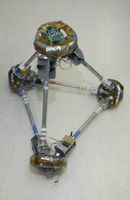NASA tests shape-shifting robot pyramid for nanotech swarms
Progress toward creating the gray goo that will eat the entire known universe. Very cool technology.Like new and protective parents, engineers watched as the TETWalker robot successfully traveled across the floor at NASA's Goddard Space Flight Center in Greenbelt, Maryland. Robots of this type will eventually be miniaturized and joined together to form "autonomous nanotechnology swarms" (ANTS) that alter their shape to flow over rocky terrain or to create useful structures like communications antennae and solar sails.
The robot is called "TETwalker" for tetrahedral walker, because it resembles a tetrahedron (a pyramid with 3 sides and a base). In the prototype, electric motors are located at the corners of the pyramid called nodes. The nodes are connected to struts which form the sides of the pyramid. The struts telescope like the legs of a camera tripod, and the motors expand and retract the struts. This allows the pyramid to move: changing the length of its sides alters the pyramid's center of gravity, causing it to topple over. The nodes also pivot, giving the robot great flexibility.

TETWalker
The team anticipates TETwalkers can be made much smaller by replacing their motors with Micro- and Nano-Electro-Mechanical Systems. Replacement of the struts with metal tape or carbon nanotubes will not only reduce the size of the robots, it will also greatly increase the number that can be packed into a rocket because tape and nanotube struts are fully retractable, allowing the pyramid to shrink to the point where all its nodes touch.
These miniature TETwalkers, when joined together in "swarms," will have great advantages over current systems. The swarm has abundant flexibility so it can change its shape to accomplish highly diverse goals. For example, while traveling through a planet's atmosphere, the swarm might flatten itself to form an aerodynamic shield. Upon landing, it can shift its shape to form a snake-like swarm and slither away over difficult terrain. If it finds something interesting, it can grow an antenna and transmit data to Earth.
Extensive research in artificial intelligence is underway to get the robots to move, navigate, and work together in swarms autonomously. The research includes development of a novel interface that integrates high-level decision-making with lower-level functions typically handled intuitively by living organisms, like walking and swarming behavior. All systems are being designed to adapt and evolve in response to the environment.
Other Links:
NASA - ANTS and SWARMS
NASA Goddard Space Flight Center
NASA tests shape-shifting robot pyramid for nanotech swarms | SpaceRef - Your Space Reference for ANTS, SWARMS and SMART Assembly

Trying to escape from captivity



0 Comments:
Post a Comment
<< Home